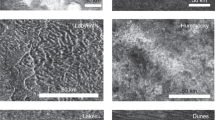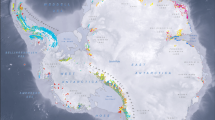Abstract
Global maps of Titan show great diversity in terrain types, but their associations with specific compositions on a large scale are obscured by Titan’s thick atmosphere, which shrouds the weak spectral features. Here we develop a principal component analysis (PCA) that enables the identification of subtle spectral features. The PCA was applied to over 13,000 Cassini/VIMS spectra that cover half of Titan’s globe, focused on tropical latitudes. Our analysis detected an ice-rich linear feature of bedrock, which extends a length equivalent to 40 per cent of Titan’s circumference. This corridor is puzzling because it does not correlate with topography or measurements of the subsurface. Ice-rich terrains in other areas of Titan occur only in local regions excavated by craters or exposed by erosion, suggesting that cryovolcanism, if active, is currently not widespread. We also find evidence for a diversity of organic sediments, formed by the photolysis of Titan’s past atmospheres, which remain to be investigated, perhaps using a similar approach.
This is a preview of subscription content, access via your institution
Access options
Access Nature and 54 other Nature Portfolio journals
Get Nature+, our best-value online-access subscription
$29.99 / 30 days
cancel any time
Subscribe to this journal
Receive 12 digital issues and online access to articles
$119.00 per year
only $9.92 per issue
Buy this article
- Purchase on Springer Link
- Instant access to full article PDF
Prices may be subject to local taxes which are calculated during checkout






Similar content being viewed by others
Data availability
The Cassini data analyszed in this work are available through the Planetary Data System (https://pds.nasa.gov). The data that support the plots within this paper and other findings of this study are available from the corresponding author upon reasonable request.
Change history
23 May 2019
In the version of this Article originally published, the author Rosaly Lopes was mistakenly affiliated with Northern Arizona University. Her affiliation has now been corrected to: Jet Propulsion Laboratory, California Institute of Technology, Pasadena, CA, USA.
References
Yung, Y. L., Allen, M. & Pinto, J. P. Photochemistry of the atmosphere of Titancomparison between model and observations. Astrophys. J. Suppl. Ser. 55, 465–506 (1984).
Cruikshank, D. P. et al. Solid C triple bond N-bearing material on outer Solar System bodies. Icarus 94, 345–353 (1991).
Clark, R. N. et al. Detection and mapping of hydrocarbon deposits on Titan. J. Geophys. Res. Planets 115, 10005 (2010).
Brown, R. H. et al. The Cassini Visual and Infrared Mapping Spectrometer (VIMS) investigation. Space Sci. Rev. 115, 111–168 (2004).
Barnes, J. W. et al. Spectroscopy, morphology and photoclinometry of Titan’s dune fields from Cassini/VIMS. Icarus 57, 400–414 (2008).
Le Gall, A. et al. Cassini SAR, radiometry, scatterometry and altimetry observations of Titan’s dune fields. Icarus 213, 608–624 (2011).
Lorenz, R. D. et al. The sand seas of Titan: Cassini RADAR observations of longitudinal dunes. Science 312, 724–727 (2006).
Soderblom, L. A. et al. Correlations between Cassini VIMS spectra and RADAR SAR images: implications for Titan’s surface composition and the character of the Huygens probe landing site. Planet. Space Sci. 55, 2025–2036 (2007).
Lopes, R. M. C. et al. Cryovolcanism on Titan: new results from Cassini RADAR and VIMS. J. Geophys. Res. Planets 118, 416–435 (2013).
Barnes, J. W. et al. Global-scale surface spectral variations on Titan seen from Cassini/VIMS. Icarus 186, 242–258 (2007).
Le Mouélic, S. et al. The Cassini VIMS archive of Titan: from browse products to global infrared color maps. Icarus 319, 121–132 (2019).
Solomonidou, A. et al. Surface albedo spectral properties of geologically interesting areas on Titan. J. Geophys. Res. Planets 119, 1729–1747 (2014).
Tomasko, M. G. et al. Rain, winds and haze during the Huygens probe’s descent to Titan’s surface. Nature 438, 765–778 (2005).
Janssen, M. A. et al. Titan’s surface at 2.18-cm wavelength imaged by the Cassini RADAR radiometer: results and interpretations through the first ten years of observation. Icarus 270, 443–459 (2016).
Radebaugh, J. et al. Dunes on Titan observed by Cassini RADAR. Icarus 194, 690–703 (2008).
Bonnefoy, L. et al. Compositional and spatial variations in Titan dune and interdune regions from Cassini VIMS and RADAR. Icarus 207, 222–237 (2016).
Soderblom, L. A. et al. The geology of Hotei Regio, Titan: correlation of Cassini VIMS and RADAR. Icarus 204, 610–618 (2009).
Lorenz, R. D. & Radebaugh, J. Global pattern of Titan’s dunes: radar survey from the Cassini PRIME mission. Geophys. Res. Lett. 36, L03202 (2009).
Lorenz, R. D. et al. A global topographic map of Titan. Icarus 225, 367–377 (2013).
Neish, C. D. et al. Crater topography on Titan: implications for landscape evolution. Icarus 223, 82–90 (2013).
Lopes, R. M. C. et al. Distribution and interplay of geologic processes on Titan from Cassini RADAR data. Icarus 205, 540–558 (2010).
Williams, D. A., Radebaugh, J., Lopes, R. M. C. & Stofan, E. Geomorphologic mapping of the Menrva region of Titan using Cassini RADAR data. Icarus 212, 744–750 (2011).
Rodriguez, S. et al. Cassini/VIMS hyperspectral observations of the HUYGENS landing site on Titan. Planet. Space Sci. 54, 1510–1523 (2006).
Ostro, S. J. et al. Cassini RADAR observations of Enceladus, Tethys, Dione, Rhea, Iapetus, Hyperion, and Phoebe. Icarus 183, 479–490 (2006).
Lopes, R. M. C. et al. Nature, distribution, and origin of Titan’s undifferentiated plains. Icarus 270, 162–182 (2016).
Werynski, A., Neish, C. D., Gall, A. L., Janssen, M. A. & the Cassini Radar Team. Compositional variations of Titan’s impact craters indicate active surface erosion. Icarus 321, 508−521 (2019).
Mitri, G. et al. Shape, topography, gravity anomalies and tidal deformation of Titan. Icarus 236, 169–177 (2014).
Nimmo, F. & Bills, B. G. Shell thickness variations and the long-wavelength topography of Titan. Icarus 208, 896–904 (2010).
Hörst, S. M. et al. Formation of amino acids and nucleotide bases in a titan atmosphere simulation experiment. Astrobiology 12, 809–817 (2012).
Mandt, K. E. et al. The 12C/13C Ratio on Titan from Cassini INMS measurements and implications for the evolution of methane. Astrophys. J. 749, 160 (2012).
Tobie, G., Lunine, J. I. & Sotin, C. Episodic outgassing as the origin of atmospheric methane on Titan. Nature 440, 61–64 (2006).
Sotin, C. et al. Observations of Titan’s northern lakes at 5 μm: implications for the organic cycle and geology. Icarus 221, 768–786 (2012).
Griffith, C. A. et al. Possible tropical lakes on Titan from observations of dark terrain. Nature 486, 237–239 (2012).
Solomonidou, A. et al. Temporal variations of Titan’s surface with Cassini/VIMS. Icarus 270, 85–99 (2016).
Griffith, C. A. et al. Radiative transfer analyses of Titan’s tropical atmosphere. Icarus 218, 975–988 (2012).
Stiles, B. W. et al. Determining Titan surface topography from Cassini SAR data. Icarus 202, 584–598 (2009).
Soderblom, J. M. et al. Geology of the Selk crater region on Titan from Cassini VIMS observations. Icarus 208, 905–912 (2010).
Neish, C. D. et al. Strategies for detecting the products of aqueous chemistry on Titan. In L unar Planet. Sci. Conf. 48, 1457 (2017).
Hayne, P. O., McCord, T. B. & Sotin, C. Titan’s surface composition and atmospheric transmission with solar occultation measurements by Cassini VIMS. Icarus 243, 158–172 (2014).
Le Mouélic, S. et al. Mapping and interpretation of Sinlap crater on Titan using Cassini VIMS and RADAR data. J. Geophys. Res. Planets 113, 4003 (2008).
Neish, C. D. et al. Spectral properties of Titan’s impact craters imply chemical weathering of its surface. J. Geophys. Res. Planets 42, 3746–3754 (2015).
Acknowledgements
C.A.G.’s research is partially funded by NASA’s Cassini Program. J.T. and N.J.M.’s work were funded by NASA space grants. P. Penteado was supported by the Northern Arizona University Office of the Vice President for Research. We thank L. Soderblom for discussions on Titan’s geology, and L. Palafox for his discussions on the blind source separation.
Author information
Authors and Affiliations
Contributions
C.A.G. developed, tested and interpreted the PCA analysis and led all aspects of the project. P.F.P. accessed and reduced all the Cassini data. J.T. and N.M. combed the Cassini data bank for viable and scientifically interesting cubes. G.M. contributed to the discussion of the ice-rich feature. C.D.N. contributed to the discussion of craters and other aspects of Titan’s geology. A.S. and R.M.C.L. put together the map of the distribution of major geomorphologic units on Titan (Fig. 6, bottom panel).
Corresponding author
Ethics declarations
Competing interests
The authors declare no competing interests.
Additional information
Journal peer review information: Nature Astronomy thanks Sylvain Douté and the other anonymous reviewer(s) for their contribution to the peer review of this work.
Publisher’s note: Springer Nature remains neutral with regard to jurisdictional claims in published maps and institutional affiliations.
Supplementary information
Supplementary Information
Supplementary Figures 1–4, Supplementary Table 1
Rights and permissions
About this article
Cite this article
Griffith, C.A., Penteado, P.F., Turner, J.D. et al. A corridor of exposed ice-rich bedrock across Titan’s tropical region. Nat Astron 3, 642–648 (2019). https://doi.org/10.1038/s41550-019-0756-5
Received:
Accepted:
Published:
Issue Date:
DOI: https://doi.org/10.1038/s41550-019-0756-5
This article is cited by
-
Exploration of Enceladus and Titan: investigating ocean worlds’ evolution and habitability in the Saturn system
Experimental Astronomy (2022)
-
Science goals and new mission concepts for future exploration of Titan’s atmosphere, geology and habitability: titan POlar scout/orbitEr and in situ lake lander and DrONe explorer (POSEIDON)
Experimental Astronomy (2022)
-
Icy lanes on Titan
Nature Astronomy (2019)
-
A global geomorphologic map of Saturn’s moon Titan
Nature Astronomy (2019)
-
Titan’s climate patterns and surface methane distribution due to the coupling of land hydrology and atmosphere
Nature Astronomy (2019)



